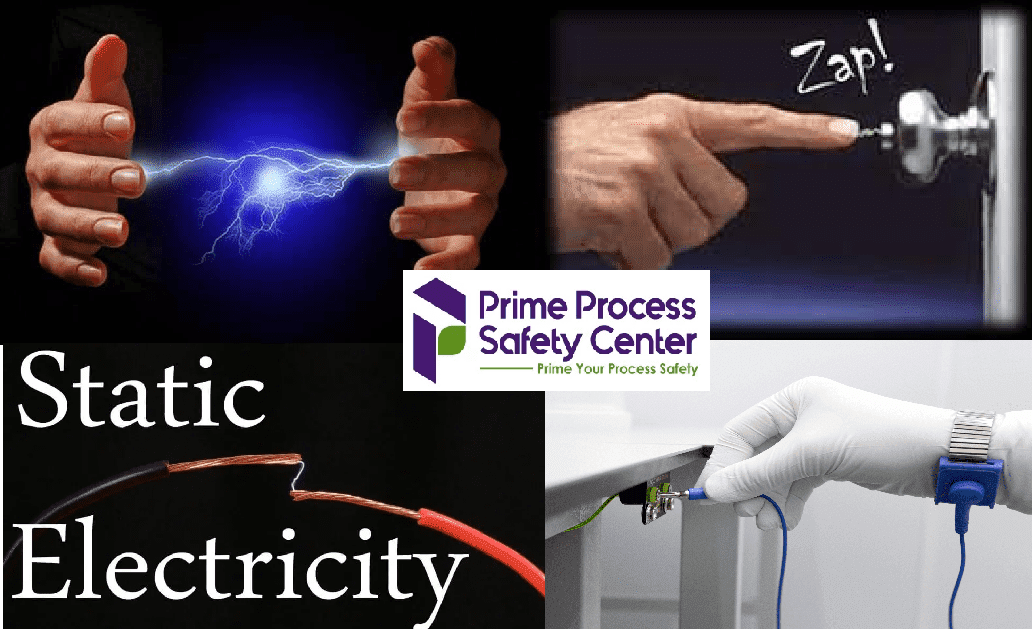
What is electrostatic discharge?
An electrostatic ignition source is a discharge resulting from the generation and accumulation of electrostatic charges. Electrostatic charge generation most frequently occurs when any two materials – liquids and/or solids – make contact with each other and then separate.
For an electrostatic hazard to occur, the following criteria must be fulfilled; there should be a flammable atmosphere which may be gases, vapors, suspended droplets or suspended dusts; there should be a process giving rise to charge generation, the charge must accumulate, the charge accumulation must be large enough to produce an electrical breakdown of the local atmosphere and the electrostatic discharges so produced must be energetic enough to ignite the flammable atmosphere.
Electrostatic hazard assessment is the process of identifying, evaluating, and mitigating risks associated with static electricity in various environments, particularly in industrial settings. The primary aim is to prevent accidents such as fires, explosions, and equipment damage that can result from electrostatic discharges. This assessment involves several key steps:
What are some risks associated with static electricity?
Electric shock due to the flow of current through the body, causing a person everything from an uncomfortable zap to falls, burns, or stopping the heart, Fires or explosions due to the ignition of flammable or explosive mixtures, Production disturbances in the processing of paper, plastics, composites, powder, granules, and liquids, Damage to electronic equipment and components from electrostatic discharge (ESD), and Damage to mechanical components such as bearings due to sparking through the oil films on the bearing surface
How are static electricity charges generated (charge generation)?
When two different materials come into contact, electrons may prefer one material over the other, leading to an electron transfer across the interface. If these materials are separated, the electrons might not fully return to their original material. In cases where both materials are good conductors, the transferred charge will return through conduction at the last contact point, leaving no trace of the charge exchange. However, if one or both materials are insulators, the transferred charge cannot move back easily, resulting in one material becoming positively charged and the other negatively charged
Why should we perform an electrostatic hazard assessment?
Performing an Electrostatic Hazard Assessment in the process industry is vital due to the inherent risks associated with static electricity in environments handling flammable or combustible materials. In industries such as chemical manufacturing, pharmaceuticals, and petrochemicals, static charges can accumulate and, if not properly controlled, lead to ignition of flammable vapors, gases, or dust, resulting in fires or explosions. These assessments help in identifying and evaluating the sources of electrostatic generation, the potential accumulation points, and the effectiveness of existing grounding and bonding systems. By systematically analyzing these factors, industries can implement appropriate safety measures to mitigate the risk of static-induced incidents. This not only ensures compliance with safety regulations but also enhances overall operational safety, protecting both personnel and assets from the potentially devastating consequences of electrostatic discharges.
What are the Preventive Measures of Electrostatic Hazard?
Static hazards are dealt with by avoiding charge generation, preventing charge accumulation or by removing the charge before there is any possibility of a discharge
- Avoiding charge generation is likely to require altering the process in some way. In many cases a small change in temperature or humidity may be all that is necessary;
- Prevention of charge accumulation is often achieved by ensuring all conducting items (including personnel, portable equipment, and fixed plant) are properly grounded. However, this has no effect on insulating equipment and materials. It is also often not appreciated that connecting metal plant to earth may have no effect on the materials being handled inside the plant;
- In some situations, there will be no alternative but to accept that charge will be generated and begin to accumulate: if the charge is accumulated on the insulating dust, one way forward is to neutralize the charge before it becomes a hazard, ensuring an appropriate relaxation time.
How can static electricity be controlled?
Ignition hazards from static electricity can be controlled by the following methods:
- Removing the ignitable mixture from the area where static electricity could cause an ignition-capable discharge
- Reducing charge generation, charge accumulation, or both by means of process or product modifications
- Neutralizing the charges, the primary methods of which are grounding isolated conductors and air ionization
- Operating outside the flammable range
How can conductive materials be bonded and grounded?
It is generally recommended that fixed conductive surfaces and equipment be grounded such that their resistance-to-ground are less than ten (10) ohms (Ω). However, a resistance-to-ground of as much as 1 x 106 ohms (1 MΩ) can be allowable for rotating and moving conductive parts of mechanical equipment, such as screw feeder screws, blender rotors and conductive probes inside of equipment. A resistance-to-ground of less than 1 x 106 ohms is generally sufficient to prevent the accumulation of a potentially hazardous level of charge on conductive surfaces and equipment. The lower value, 10 Ω, is generally recommended for fixed metallic equipment, however, since it is easily achievable, and a higher resistance generally suggests a problem with the grounding system or pathway. The grounding of conductive surfaces and equipment should be checked regularly by measurement as a part of a safety-critical Mechanical Integrity program.
How can we control static electric charge on personnel?
The human body is a conductor and subject to charge accumulation when isolated from ground. The maximum stored energy on a human body is generally not expected to exceed 30 mJ. However, the grounding of personnel is generally recommended when they may be exposed to a flammable atmosphere having a Minimum Ignition Energy (MIE) of less than 100 mJ. Personnel should be grounded such that their resistance-to-ground is less than 1 x 108 ohms (100 MΩ) to prevent the accumulation of a potentially hazardous level of electrostatic charge. However, their resistance should be no lower than 5 x 104 ohms (50 kΩ) in order to protect them from potential electrocution hazards. Steps to prevent charge accumulation include the use of the following:
- Conductive or static dissipative flooring and footwear
- Personnel-grounding devices
- Antistatic or conductive clothing
What are the applicable standards for static control in flammable and combustible atmospheres?
NFPA 77 guides on “identifying, evaluating, and controlling static electric hazards to prevent fires and explosions. Other applicable codes and standard includes API RP 2003: Protection Against Ignitions Arising Out of Static, Lightning, and Stray Currents and IEC 60079-32-1: Electrostatic Hazards – guidance
What is electrostatic hazard assessment?
Electrostatic hazard assessment is the process of identifying, evaluating, and mitigating risks associated with static electricity in industrial and other environments.
Why is electrostatic hazard assessment important?
It is crucial to prevent fires, explosions, and equipment damage caused by electrostatic discharges in industries handling flammable materials or sensitive electronics.
What industries require electrostatic hazard assessments?
Industries such as chemical manufacturing, pharmaceuticals, petroleum, mining, electronics, and food processing often require these assessments.
What are common sources of static electricity in industrial settings?
Common sources include friction between materials, fluid flow through pipes, handling of powders, and movement of conveyor belts.
What is an electrostatic discharge (ESD)?
An ESD is a sudden flow of electricity between two electrically charged objects caused by contact, an electrical short, or dielectric breakdown.
How can static electricity cause fires and explosions?
Static electricity can ignite flammable vapors, gases, or dusts when a discharge occurs, providing an ignition source.
What are some common methods to control static electricity?
Methods include grounding and bonding, humidity control, antistatic agents, conductive flooring, and proper material handling practices.
What is grounding and bonding?
Grounding involves connecting objects to the earth to eliminate charge buildup, while bonding connects two objects to equalize their charge.
How does humidity affect static electricity?
Higher humidity levels increase the conductivity of materials, helping dissipate static charges, while low humidity promotes charge buildup.
What are antistatic agents?
Antistatic agents are chemicals applied to surfaces to reduce static charge accumulation by increasing surface conductivity.
What is a safe threshold for static charge accumulation?
While it varies by material and environment, generally, static charge should be kept below 1 kV to prevent hazardous discharges.
How can clothing contribute to static hazards?
Synthetic fabrics can generate and hold static charge, so antistatic or conductive clothing is recommended in hazardous environments.
What role do footwear and flooring play in static control?
Conductive footwear and flooring help dissipate static charges from personnel to the ground, reducing the risk of discharge.
Can static electricity affect electronic equipment?
Yes, ESD can damage sensitive electronic components, leading to malfunction or failure, making ESD control critical in electronics manufacturing.
What is the purpose of an electrostatic hazard assessment?
To identify potential sources of static electricity, evaluate the associated risks, and implement measures to mitigate those risks.
What are some indicators of a potential electrostatic hazard?
Indicators include frequent small shocks, visible sparks, and the accumulation of dust in areas where it shouldn’t be.
How often should electrostatic hazard assessments be conducted?
Assessments should be conducted regularly, especially when there are changes in processes, materials, or equipment.
What standards or guidelines are followed in electrostatic hazard assessment?
Standards include NFPA 77, IEC 61340, and OSHA guidelines, among others, which provide detailed procedures and safety measures.
Can portable electronic devices pose a static hazard?
Yes, portable electronic devices can generate static and should be used cautiously in hazardous environments.
How do you measure static electricity?
Static electricity can be measured using instruments such as electrostatic voltmeters, field meters, and charge plates.
What is an electrostatic discharge protective area (EPA)?
An EPA is a designated area with controls to protect sensitive components from ESD, including grounded work surfaces and tools.
What are the consequences of not addressing electrostatic hazards?
Consequences include fires, explosions, equipment damage, production downtime, and potential injury or loss of life.
What training is required for personnel regarding electrostatic hazards?
Personnel should be trained on static electricity sources, hazards, and control methods, and how to properly use and maintain ESD protection equipment.
Can static electricity be completely eliminated?
It is nearly impossible to eliminate static electricity entirely, but it can be effectively controlled to safe levels.
What are some examples of personal protective equipment (PPE) for static control?
Examples include antistatic wrist straps, conductive shoes, grounding cords, and antistatic clothing.
How do you determine if a material is prone to static buildup?
Material properties like resistivity, humidity sensitivity, and triboelectric characteristics help determine static buildup propensity.
What is the triboelectric series?
The triboelectric series is a list of materials ranked by their tendency to gain or lose electrons, which helps predict static charge generation.
How can you safely discharge static electricity?
Safe discharge methods include grounding, using ionizing equipment, or controlled discharge through resistive paths.
What is an ionizer and how does it work?
An ionizer neutralizes static charge by emitting positive and negative ions that attract and neutralize charges on nearby surfaces.
What role do process modifications play in electrostatic hazard control?
Modifying processes to reduce friction, control flow rates, and avoid static-prone materials can significantly reduce electrostatic hazards.
What Services does Prime Process Safety Center offer
Prime Process Safety Center offers the following Combustible Dust Consulting Services; Combustible Dust Hazard Analysis (DHA), Ignition Sources Assessment, Electrostatic Hazard Assessment, Hazardous Area Classification, Fire and Explosion Hazard Analysis, Explosion Prevention and Protection Consulting Services, Fire and Building Code Services, Incident Investigation, Expert Witness and Litigation. Moreover, Prime Process Safety Center offers the following combustible dust testing services Go/No Go Explosibility Screening, Burn Rate / Fire Train Test, Dust Explosion Severity (Kst/Pmax/dP/dt), Minimum Explosible Concentration (MEC)/Lower Explosible Limit (LEL), Limiting Oxygen Concentration (LOC) Test, Minimum Ignition Energy (MIE), Minimum Autoignition Temperature-Cloud (MAIT – Cloud), Layer Ignition Temperature of Dust (LIT), Volume Resistivity, Surface Resistivity, Charge Decay (Relaxation) Time, Breakdown Voltage, Flexible Intermediate Bulk Containers (FIBC), Electrostatic Chargeability Testing, Basket Self-Heating, Grewer Oven Test, Air Over Layer/Powder Layer Test, Bulk Powder Test, Aerated Powder Test

